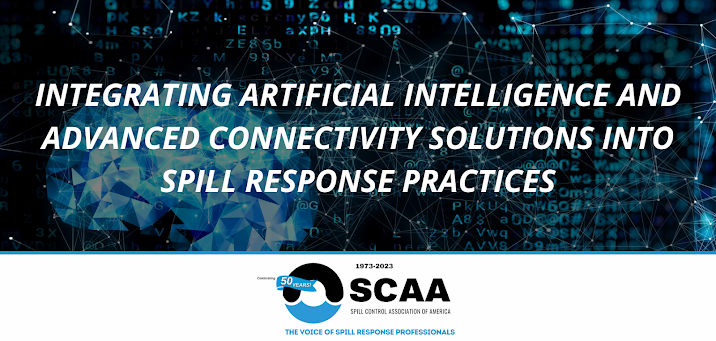Integrating Artificial Intelligence and Advanced Connectivity Solutions into Spill Response Practices
The oil and gas industry is continually evolving, and with it, so are the methods used to manage and mitigate the environmental impact of spills. Artificial intelligence (AI) and advanced connectivity solutions can be combined and integrated to create powerful tools for managing spill response. These technologies can streamline access to preplanned response strategies and provide real-time support to tactical teams in the field, ushering in a new era of rapid and effective spill management.
The Power of AI in spill control technology has the potential to revolutionize spill control in various ways. From AI-powered document management to automated plan updates, compliance monitoring, and predictive analytics for improved spill prevention, the possibilities are endless. As we move away from traditional applications and embrace the power of AI, we can harness these capabilities to enhance response coordination, making critical information readily available to operational teams in the field.
For example, Starlink, a satellite-based internet service, offers high-speed, low-latency connectivity that can significantly improve the delivery of AI services. By leveraging this advanced connectivity, we can enable the integration of emerging technologies and create a more connected and technologically advanced future for spill response. With faster, more reliable internet access, AI-powered tools can be used in real-time, even in remote locations, enhancing the efficiency and effectiveness of spill response operations.
Integration will be key to unlocking the full potential of AI and advanced connectivity solutions in the spill response industry. By moving away from standalone applications and towards integrated systems, we can empower tactical teams with the ability to access and utilize preplanned response strategies more efficiently. This shift will not only increase the speed at which we can react to spills, but also enable a more proactive approach to spill prevention and management by enabling data driven decision making instead of reactionary decisions.
By combining AI and advanced connectivity solutions, we can create powerful tools to support tactical teams in the field and assist facilities in compliance issues. These technologies can help to:
- Streamline access to critical information, such as preplanned response strategies and real-time data.
- Use Case
- The spill control industry has long relied on comprehensive plans such as Facility Response Plans (FRP), Geographical Response Plans (GRP), DOT/PHMSA plans (DOT), and Spill Prevention Control and Countermeasures plans (SPCC). These documents are crucial for managing emergencies, but they can be lengthy, repetitive, and complicated. In recent years, artificial intelligence (AI) has emerged as a potential game-changer in streamlining these processes.
AI-Powered Document Management
Integrating AI into the spill control industry can help users quickly locate the specific information they need within these plans. By using natural language processing (NLP) algorithms, an AI-driven reader can quickly search through hundreds of pages and images, providing relevant information in seconds. This not only saves time but also reduces the risk of human error in locating critical data.
Automated Plan Updates and Compliance Monitoring
AI can also be used to monitor changes in regulations and industry standards, ensuring that FRP, GRP, DOT, and SPCC plans are always up to date. By automating the process, organizations can stay compliant more easily, reducing the risk of penalties and fines.
- Enhance collaboration and communication between various stakeholders, including regulatory agencies, emergency responders, and decision-makers.
- Use Case
- AI-Powered Document Management-National Incident Management System
One of the key areas where AI can streamline NIMS is in document management. Incident Command System (ICS) forms are essential for effective communication and coordination during emergencies. By leveraging AI-powered tools, these forms can be automatically generated from digital forms that responders generate during the emergency response activities and distributed based on real-time data and predefined instructions already defined by NIMS. This would save time, reduce human error, and ensure that relevant information is accurately and consistently documented.
- Enhanced Predictive Analytics
Artificial Intelligence can bring forth many advantages to NIMS, especially in the form of comprehensive analytics which is impossible if we continue to use traditional paper-based data and practices. Unfortunately, despite the industry becoming more accustomed to seeing digital formats, these advantages have not been fully capitalized on. By analyzing vast amounts of digital data from the human and AI generated ICS forms, AI algorithms can identify patterns and trends to predict potential incidents or emergencies. This information can be used to better allocate resources, develop proactive response strategies, improve overall preparedness, and create a safer work environment.
- Increase the overall effectiveness and efficiency of spill response operations.
- Only if we adopt digital response strategies and practices.
The marriage of AI and advanced connectivity has the potential to revolutionize the spill response industry. By integrating these technologies, we can move closer to a future where spills are managed more effectively and efficiently, minimizing their environmental impact, and safeguarding our planet for generations to come. As we continue to innovate and embrace new technologies, we can lead the way in creating a safer and more sustainable future for the oil and gas sector.

Comments
Post a Comment